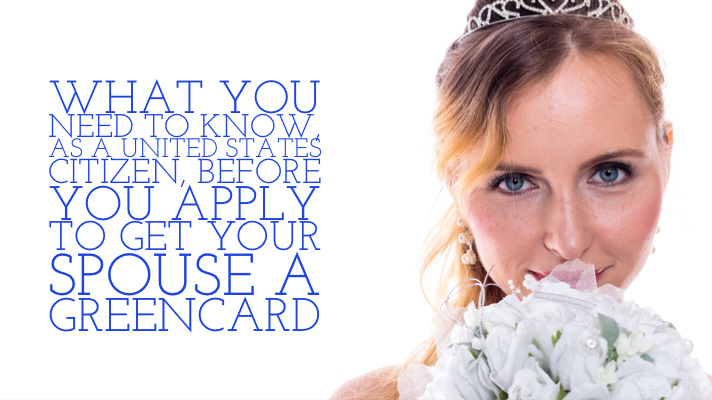
There are countless blossoming romances happening right now all around the world. Many of those relationships involve couples who have large age differences, religious differences, cultural differences, and more. Often, U.S. citizens fall in love with and marry people from other countries. The process of obtaining a greencard (officially known as a Lawful Permanent Resident card) for that spouse should be easy. But it’s not. Even if the marriage is clearly real, the non-citizen spouse can be denied a greencard if you do not submit sufficient evidence that the marriage is real.
What do I have to prove in order to get my non-citizen spouse a greencard?
The process is different depending on your circumstances (i.e. is your spouse in the country or out of country), but one thing is always required. If you are filing a petition with USCIS (United States Citizenship and Immigration Services) to establish your relationship to your spouse, you will have to prove that the marriage is “bona fide.” In other words, you have to prove that your marriage is real. It was not entered into for the sole purpose of evading the immigration laws. This doesn’t mean that a couple can’t decide to get married earlier than they normally would so they aren’t separated when the non-citizen has to leave the country. It simply means that two people can’t get married solely so the non-citizen can stay in the U.S. when they do not intend to live as husband and wife.
What evidence should I submit to USCIS to get a greencard?
USCIS is looking for documented evidence that you and your spouse have intertwined your lives together in the way that most spouses do. This is where most people fall short. They want to see evidence throughout the existence of the relationship. So, if you have been together for 15 years, you should submit evidence throughout that 15 year period. If you have been together for three months, you should submit evidence for that entire three month period.
You should also submit sufficient evidence. Many people will simply submit one month’s bank statement, a few photos, a utility bill, and a phone bill. But this is not sufficient. They want to see an ongoing financial relationship. They want to see bank statements throughout the marriage showing that both of your incomes are going into that account and both of you are spending out of that account. They want to see utility statements, phone statements, insurance statements, leases deeds, and more all throughout the marriage. They want to see text message printouts, phone records, facebook post printouts, photos, airline tickets and baggage claim tickets from trips taken, and more.
Of course, this evidence will not be available in every case. If you just got married, then you probably haven’t joined your lives together yet. If you spouse is overseas and you are trying to bring him or her here, then you probably haven’t financially tied your lives together. In those case, you should beef up the other evidence of your relationship that you have. You should accumulate evidence of the contact you have had with your spouse since you began your relationship, which includes text messages, photos, evidence of trips taken together, and more.
The main thing to take away is that you have the burden of proof to prove that your relationship is bona fide. Before filing your petition, you should do everything in your control to financially tie yourself to your spouse. Have his or her name placed on the lease/deed, utilities bill, phone bill, etc. Start collecting photos, text messages, phone records, and more. Save your baggage claim tickets. The more you prepare before you file, the better off you will be.
What if I don’t submit enough evidence?
If you don’t submit enough evidence that the marriage is real, you can be issued an RFE (Request for Evidence) or your petition can be denied. This can cause great delays in an already backlogged process. The current processing time at the time of writing this article is 5-7 months. If you are issued an RFE, you may be given up to 87 days to respond. It may then take many months for USCIS to adjudicate the case after the RFE. If they deny the petition, you can file again with more evidence, but you must pay new filing fees and start back at the beginning, having to wait the normal processing time.
So, what should I do?
You have two options. If you can afford it and you don’t want to risk a denial or deal with the headache of learning how to file yourself, you can hire a competent immigration attorney to do it for you. The benefit of this is that you don’t have to waste a whole lot of time dealing with the bureaucracy and trying to figure out what you are supposed to do. You can also get your questions answered throughout the process. The downside is the expense. So only you can make the cost/benefit analysis. Either way, you can save yourself a lot of headaches by starting the process as early as possible. Document your relationship. Add your spouse to all of your financial accounts – bank accounts, utility accounts, phone accounts, insurance accounts, lease/deed, etc. Photograph your time together. Keep receipts and other documents. Place everything in an expandable file folder. Place a copy of each months statements in the folder. When you are ready to file, you will have all of the evidence right at your fingertips. Good luck!
 Jeremy Lasnetski is a partner at the Law Offices of Lasnetski Gihon Law. The firm focuses on criminal defense, immigration and personal injury. Mr. Lasnetski focuses his practice on immigration and criminal defense. Mr. Lasnetski is the former Jacksonville Regional Vice Chair of the American Immigration Lawyer’s Association, Central Florida Chapter and has represented clients in deportation proceedings, USCIS benefit cases, consular processing cases, and more. He routinely gives presentations on immigration law issues to both criminal and immigration lawyers at conferences and seminars throughout the State of Florida.
Jeremy Lasnetski is a partner at the Law Offices of Lasnetski Gihon Law. The firm focuses on criminal defense, immigration and personal injury. Mr. Lasnetski focuses his practice on immigration and criminal defense. Mr. Lasnetski is the former Jacksonville Regional Vice Chair of the American Immigration Lawyer’s Association, Central Florida Chapter and has represented clients in deportation proceedings, USCIS benefit cases, consular processing cases, and more. He routinely gives presentations on immigration law issues to both criminal and immigration lawyers at conferences and seminars throughout the State of Florida.
 Florida Immigration Lawyer Blog
Florida Immigration Lawyer Blog

